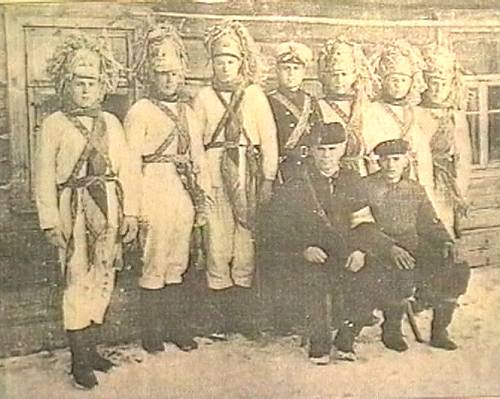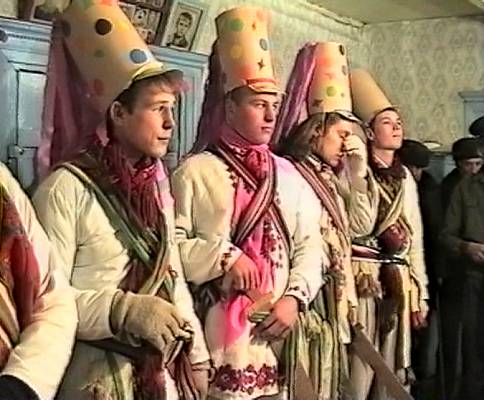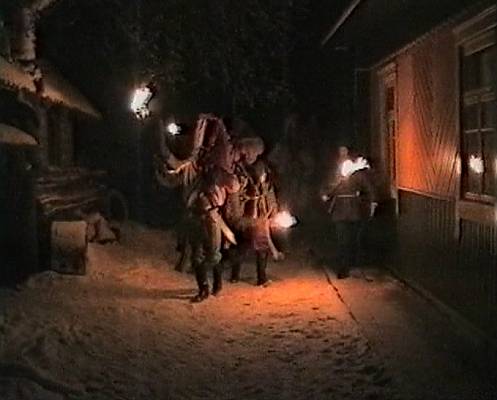Report on the status of an element inscribed on the list of intangible cultural heritage in need of urgent safeguarding
A. Cover sheet
A.1.
State Party
Name of State Party
Belarus
A.2.
Date of deposit of the instrument of ratification, acceptance, approval or accession
This information is available online.
Date of deposit of the instrument of ratification, acceptance, approval or accession
2005-02-03
A.3.
Element inscribed on the Urgent Safeguarding List that is the subject of this report
Name of element
Rite of the Kalyady Tsars (Christmas Tsars)
Inscribed in
2009
Submitting State(s)
Belarus
A.4.
Reporting period covered by this report
Please indicate the period covered by this report.
Reporting period covered by this report
15-12-2018 - 15-12-2021
A.5.
Other elements inscribed on the Urgent Safeguarding List, if any
Please list all other elements from your country inscribed on the Urgent Safeguarding List, together with the year of inscription; for multinational elements, please indicate the other States concerned.
Other elements inscribed on the Urgent Safeguarding List, if any
Spring rite of Juraŭski Karahod (2019)
A.6.
Executive summary of the report
Please provide an executive summary of the report that will allow general readers to understand the current status of the element, any positive or negative impacts of inscription, the implementation of safeguarding measures during the reporting period and their possible update for the following years.
Executive summary of the report
The rite of "Kalyady Tsars" (Christmas Kings) was inscribed in the UNESCO List of Intangible Cultural Heritage in Need of Urgent Safeguarding in 2009. This rite is celebrated on January 13th annually by residents of Semezhava village (Minsk Region). It is the day before the New Year (according to the old Julian calendar) known as "Generous Evening". The ritual is part of the traditional Belarusian Christmas and New Year carnival. Traditionally, the ceremony is held by local young guys who, on a generous evening, go around the villagers' homes and perform the folk play "Tsar Maximilian". Traditionally, this play was always shown at Christmas by the Belarusian puppet theatre "Batlejka". Still, in Semezhava, the puppet theatre was transformed into a folk theatre with "live" actors. After the performance, the villagers present the artists with Christmas treats and sweets. This rite concludes the Christmas period and marks the beginning of the New Year. The arrival of "kings" contributes to the well-being of each family and the prosperity of the village. The idea of ??the "Kalyady Tsars" ritual embodies the values ??of friendship, cooperation, and harmony of man and nature and serves as a factor of self-identification of the villagers. It has happened that in the 20th century, the rite went through a period of oblivion (since the end of 1960, it was banned by the atheist Soviet regime as a relic of a religious cult). Still, in 1996, it was completely restored thanks to the local activists' efforts. It has been constantly practised and supported by its bearers from then. When the rite was inscribed in the ICH Urgent Safeguarding List, there were some risks related to its safety and viability. For example, demographic and social problems (ageing of villagers, a lack of work and, as a result, the outflow of young people to the city). However, from 2009 to the present, several protective measures have been implemented. They have proven their effectiveness thanks to the purposeful work of both residents and local authorities and other partners, among which are members of Student Ethnographic Society, experts of the National Academy of Sciences, Belarusian State University, Belarusian Association of Rural Tourism, various media, etc.
During the reporting period, the following safeguarding measures were implemented:
(1) the constant transmission of the element was ensured by attracting new rite young performers and by a systematic learning process carried out by experienced bearers for the young.
(2) active research, documentation and inventorying of local heritage began. A relevant database has been created, including documents, photos, audio and video materials. The local cultural centre attracts residents, primarily young people, for data collecting.
3) active work was provided for raising awareness and disseminating knowledge about Semezhava ICH and the "Kalyady Tsars". During the celebration of the 10th anniversary of the rite's inclusion in the UNESCO List, the press was especially active. Exhibitions dedicated to the ceremony in museums and other places have opened.
6) the socio-economic climate in Semezhava has improved due to the development of the local agro-cultural complex, but demographic problems are still relevant. In the next four-year period, it is planned to strengthen the capacity building of locals, especially women, to acquire modern knowledge in social entrepreneurship and sustainable development.
The local community recognizes the rite as an essential part of its cultural identity and actively support it. It researches other types of heritage, tangible and intangible, promoting them, attracting cultural and tourist organizations, the media, and various funds, and developing new forms of non-formal education.
A.7.
Contact person for correspondence
Provide the name, address and other contact information of the person responsible for correspondence concerning the report.
Title (Ms/Mr, etc.)
Ms
Family name
Khvir
Given name
Natalya
Institution/position
Head Department for the Protection of Historical and Cultural Heritage Ministry of Culture of the Republic of
Address
Pobeditelej Avenue 11
Minsk 220030
Telephone number
+375 44 5351 830
E-mail address
n.khvir@gmail.com
Other relevant information
B
Ms
B. Status of element inscribed on the Urgent Safeguarding List
Refer to the nomination file or to previous reports, if any, as the basis for reporting on the current status of the element, and report only on relevant changes since the date of inscription on the List or since the previous report. Nomination files, specific timetables and earlier reports, if any, are available at https://ich.unesco.org or from the Secretariat, upon request.
The State Party shall pay special attention to the role of gender and shall endeavour to ensure the widest possible participation of the communities, groups and, where applicable, individuals concerned as well as relevant non-governmental organizations during the process of preparing this report, and is asked to describe how it has done so in point D below.
B.1.
Social and cultural functions
Please explain the social and cultural functions and meanings of the element today, within and for its community, the characteristics of the bearers and practitioners, and any specific roles or categories of persons with special responsibilities towards the element, among others. Attention should be given to any relevant changes related to inscription criterion U.1 (‘the element constitutes intangible cultural heritage as defined in Article 2 of the Convention’).
Social and cultural functions
The rite of "Kalyady Tsars" is a marker of the cultural identity of the Semezhava community. All villagers share this idea, regardless of age, gender, social or ethnicity. Even the people who settled in the village during the past 20 years also consider this event as necessary in their life. Locals prepare for it in advance, and this holiday premonition becomes especially exciting every time after the New Year's arrival. In January 2021, the procession of the kings did not take place due to the COVID 19 pandemic. It was a very negative sign for many locals. The kings' visit is considered a good omen and a sign of well-being in the coming year. Semezhava residents (adults and children) are waiting for the arrival of the kings and are very happy to meet them. They actively prepare for the kings' coming and discuss the holiday details in advance. Thus, the rite continues to perform a consolidating and axiological function for the local community. In addition, it is part of the traditional Belarusian Christmas and New Year carnival. It is historically inscribed in the folk calendar and synergistically and semantically reflects a deeper level of cultural interaction.
The annual practice of the rite fulfils, among others, the function of transmitting the social experience from generation to generation, thus safeguarding local cultural memory as an essential attribute of the local community's social presence.
The educational and cognitive aspect of this ICH element also remains essential. The more experienced and older rite participants (who played the kings' roles in the past) transfer their knowledge to the younger through apprenticeship. Pieces of training are held at the local cultural center, wherein in 2019, a particular room for activities and meetings was equipped with a UNDP grant. Georgy Tsimanau (a local activist who restored the ritual in 1996) and other kings conducted the lessons. At present, quite a lot of young people participate in the ceremony. Today, the roundabout ritual is performed by three groups of kings, which, to the delight of the villagers, can "bring the holiday" to more houses. The rite also performs a regulatory function associated with the local public life. It is included in the system of their traditional holiday culture. It thus provides specific moral and behavioural rules for residents, including young people, for whom participation in the ceremony is a tribute to their family, ancestors, and villagers.
B.2.
Assessment of its viability and current risks
Please describe the current level of viability of the element, particularly the frequency and extent of its practice, the strength of traditional modes of transmission, the demographics of practitioners and audiences and its sustainability. Please also identify and describe the threats, if any, to the element's continued transmission and enactment and describe the severity and immediacy of such threats, giving particular attention to any strengthening or weakening of the element’s viability subsequent to inscription.
Assessment of its viability and current risks
The rite of Kalyady Tsars of Semezhava village was reborn in 1996, after 20 years of oblivion of the Soviet period, at the initiative of the local community, and primarily thanks to the tireless research work by local activists Georgy Tsimanau and Tatiana Shaura (now - the head of the Semezhava cultural center). Since then, the ceremony has been held annually at the set time - January 13th. But in 2021, due to the COVID 19 pandemic, the Kalyady Tsars did not go out on their traditional New Year-round (in January 2020, the danger of coronavirus in Belarus was not yet evident, and the holiday took place). Of course, this was not a simple challenge for locals and provoked negative emotions in some elderly since they associate some sacral functions with the rite.
Since the ritual was inscribed in the ICH Urgent Safeguarding List, this element has become more sustainable because the local community has taken particular actions. So, in Semezhava, there is a constant transfer of knowledge and experience related to the ceremony from the older generation to the younger ones. After obtaining UNESCO status, capacity-building training has become systematic and carried out at the local cultural center. The center now serves as an Information and Visiting Service for residents and visitors (journalists and tourists). It contains the rite archive, various workshops and events are organized, for example, the annual festival of local cuisine, exhibitions, and concerts. A photo and documentary exhibition dedicated to the Kalyady Tsars is open in the center.
Every year a large number of visitors come to Semezhava for the ceremony. After including this intangible value in the UNESCO List, the residents experienced a real shock facing such a mass of people. Over time, they learned to regulate the flow of visits, delimiting the surrounding space into zones, allocating a site for holding a fair. It is provided a few hours before the kings' procession. Everyone can taste local dishes and buy local handicrafts and souvenirs here. Locals also offer accommodation and food to visitors.
Among the risks still relevant for the Semezhava community, there is a demographic problem (the departure of young people from the countryside for the improvement in the quality of life), which has become somewhat aggravated recently due to the general economic situation in the country. There are risks associated with a pandemic and the need to follow a hygiene protocol, which, of course, poses a threat to the ceremony itself and affects the mood of community members. There were also examples of unethical behavior in the media (interference with the tradition, attempts of unauthorized access, etc.) There are attempts to use the ceremony participants to present the rite during other holidays (for example, festivals). Nevertheless, the community managed to protect itself from such actions by developing and approving at the general meeting the Community Protocol, which regulates access to the ceremony, contains the conduct rules during the ceremony and some other conditions that protect the rights of its participants.
B.3.
Implementation of safeguarding measures
Please report on the safeguarding measures described in the nomination file, and previous report, if any. Describe how they have been implemented and how they have substantially contributed to the safeguarding of the element during the reporting period, taking note of external or internal constraints such as limited resources. Include, in particular, information on the measures taken to ensure the viability of the element by enabling the community to continue to practise and transmit it. Include the following detailed information concerning the implementation of the set of safeguarding measures or safeguarding plan:
B.3.a.
Objectives and results
Indicate what primary objective(s) were addressed and what concrete results were attained during the reporting period.
Objectives and results
All planned safeguards for the element were implemented mainly and expanded according to the objectives and expected results during the reporting period. The goals were achieved as follows:
(1) Research, documentation, and inventorying of the "Kalyady Tsars" rite in the context of the Semeshava culture and traditions.
The rite's research and documentation have been carried out continuously since 1966, when residents revitalized it after a long break. This activity was done by the bearers themselves and experts. In 2019, a database of documents, photos, audio, and videos related to the cultural heritage of Semezhava, including the rite, was created. Locals are actively involved in the process of data collecting and documenting. Many bring old photographs, documents, artefacts. In 2020 the inhabitants brought and presented 18 homespun belts, scarves, boots for the performers of the kings.
(2) Transmission of knowledge and information about the 'Kalyady Tsars' rite.
During the reporting period, continuous work was carried out to transfer knowledge and experience related to the Kalyady Tsars, both within the community and for the wider public, through seminars, festivals, conferences, competitions, and other events on the national and local scale. In 2019, the exhibition dedicated to the Semezhava ICH was opened at the National History Museum. In 2020, Belarusian TV (Belarus 3 Channel) released a video film dedicated to the Kolyady Tsars (in the TV series 'Living Culture'). The rite bearers, the local community members and experts took part in a TV show on the current state of the ICH elements included in the UNESCO lists" (2020). The Semezhava cultural center constantly works with local schoolchildren, publishes informational booklets, helps participants in the Tsars' ceremony organize the January 13 celebration, and attracts local women to promote the local cuisine during the festival and other local events.
(3) Promotion of the 'Kalyadny Tsars' rite.
The ceremony every year attracts a large number of media and visitors who come to Semezhava to celebrate the Generous Evening there. The media, including foreign ones, widely cover this event. ICH bearers and local activists took part in exhibitions at the National History Museum (2019), the Minsk Regional Center of Folklore (2018), in the thematic exhibition "The Heritage of Belarus" at the Palace of the Republic (Minsk, 2021). During the last few years, the Semezhava House of Crafts has been preparing exhibitions and fairs of local artisans during the ceremony and has also prepared a series of beautiful souvenirs for guests and tourists visiting the village.
(4) Capacity building of community members.
This task is successfully solved by the rite bearers themselves, conducting workshops and consultations for young people who wished to participate in the ceremony, passing on to the knowledge and skills related to the ICH element (see P. B2). Locals also participated in various seminars and exhibitions organized by the Minsk Regional Center of Folklore, the Kapyl Museum of Local Lore, and the Kapyl Center of Traditional Culture; attended folklore festivals in other Belarusian regions.
B.3.b.
Safeguarding activities
List the key activities that were carried out during this reporting period in order to achieve these expected results. Please describe the activities in detail and note their effectiveness or any problems encountered in implementing them.
Safeguarding activities
Measures for safeguarding the 'Kalyady Tsars' rite were implemented by its bearers and experts, cultural and educational institutions, non-governmental organizations, state and local authorities to ensure the element's viability, its constant transmission, and promotion.
Thus, taking into account the tasks set for the reporting period (2018-2021), the following safeguarding activity was implemented:
Objective1. Research, documentation, and inventorying of the "Kalyady Tsars" rite in the context of the Semeshava culture and traditions.
At the Semezhava cultural center, a database of documents, photos, audio, and video recordings related to the history and cultural heritage of the Semezhava village has been developed and created, including data on the local intangible cultural heritage -- the 'Kalyady Tsars' rite. The participants of the ceremony and local activists and lovers of local history and culture were involved in collecting and developing the database. Local people shared old photographs, memories, brought artefacts related to the history of the rite. The database also contains copies of publications in the press related to the ceremony after its renovation in 1996.
At the Semezhava cultural center, in honour of the 10th anniversary of the 'Kalyady Tsars' inclusion in the UNESCO Urgent Safeguarding List, a permanent informational and photo exhibition dedicated to the history of the rite and activities for its safeguarding was produced.
Another element of the ICH from Semezhava, 'Red and White Weaving', was inscribed in the National Inventory of the ICH (http://living-heritage.by/nks/2020/?sphrase_id=66925) and the State List of Historical and Cultural Values ??of the Republic of Belarus ( http://gosspisok.gov.by/Home/Index) (2018). The activity on preparing the new nomination concerning local culinary traditions started in 2021.
Objectives 2-3. Transmission of knowledge and skills concerned with the 'Kalyady Tsars' rite and its promotion.
After the rite of the "Kalyadny kings" was inscribed in the UNESCO List, it is constantly in the field of view of the press (national, regional, and local). Many journalists come to the holiday, including those from foreign, as a rule, countries. On the 10th anniversary of obtaining UNESCO status (2019), more than 100 representatives of the press worked at the celebration in Semezhava. The TV company Belarus 3 created a video dedicated to the ceremony (part of the documentary television series "Living Culture"). The bearers of the ceremony, representatives of the local community and experts, took part in a TV show on the current state of the ICH elements inscribed in the UNESCO lists" (2020, Belarus - 24). Exhibitions dedicated to the Kalyady Tsars were opened at the National History Museum and the Palace of the Republic (2019, 2021). See also p. B3.a.
Objective 4. Capacity building of community members.
Among the capacity-building activities, there were seminars and pieces of training conducted by the ICH bearers themselves (experienced ritual participants) for their young colleagues (see paragraphs B2, B3a). It is an ongoing activity carried out in preparation for the ceremony. Participants of the ceremony performed at the local school and for visitors to the Kapyl Museum of Local Lore with lectures and at various seminars on ICH, transferring their experience and knowledge of the safeguarding of the rite
During the reporting period, a particular room for training and seminars was equipped in the local cultural center, computer equipment, sound recording devices were purchased, and new costumes for the Tsars were sewn by the hands of the employees Semezhava House of Crafts. Residents donated 18 homespun belts, scarves, and boots to the ceremony participants.
B.3.c.
Participation of communities, groups or individuals in the safeguarding activities
Describe how communities, groups or, if appropriate, individuals as well as relevant non-governmental organizations have effectively participated, including in terms of gender roles, in the safeguarding measures. Describe the role of the implementing organization or body (name, background, etc.) and the human resources that were available for implementing safeguarding activities.
Participation of communities, groups or individuals in the safeguarding activities
Local people consider the 'Kalyady Tsars' rite a marker of their cultural identity and carefully guard it, observing all the rules and ethical principles associated with the ritual. More experienced bearers of the ceremony are involved in activities to increase the capacity building of young participants and educational activities. They give lectures to local schoolchildren, visitors in Kapyl Local History Museum and participate in workshops related to the ICH safeguarding and transmitting, which the Minsk Regional Center of Folklore periodically holds. Local activists from the village of Semezhava and ICH bearers participate in the research, documentation, and archiving of data on the history and cultural heritage of their village.
All residents of Semezhava participate in the practice of the ceremony. The active roles in the ceremony are usually performed by young guys (12 Kalyady Tsars and several mythological characters). Still, local children follow the kings and participate in the ceremony and theatrical performance. The rest of the locals receive the kings in their homes, sharing with them this festive ("Generous") evening on the eve of the "old New Year". Local people also welcome and receive visiting guests, providing them with accommodation, if necessary, and inviting them to share a festive meal with them. On the ceremony day, the locals always hold a Traditional Crafts and Local Cuisine Fair, which also offers the opportunity to sample local food.
The local House of Crafts specialists have mastered creating various souvenirs prepared for each holiday and offered to guests in recent years. They are very varied and of good quality.
Local authorities (the Kapyl district and Semezhava village councils) also provide significant support to the community, financing various events and encouraging the bearers of the ceremony with multiple prizes and awards. The authority of the agricultural sector of Semezhava village also provides financial support to the bearers of the ICH.
B.3.d.
Timetable
Indicate in a timetable when each activity was implemented.
Timetable
Objective1. Research, documentation, and inventorying of the "Kalyady Tsars" rite in the context of the Semeshava culture and traditions.
Activity 1: Creation of a database of documents, photos, audio, and video recordings related to the history and cultural heritage of Semezhava (2018 — 2019).
Responsible: Semezhava Cultural Center, Semezhava Village Council, Kapyl District Center of Traditional Culture, Kapyl Museum of Local Lore, Semezhava House of Crafts.
Activity 2: Elaboration and production of the Informational and photo exhibition dedicated to the history of the rite and activities for its safeguarding in the Semezhava Cultural Center (2019).
Activity 3: Inventorying of Semezhava ICH, inscribing new elements in the National Inventory of ICH (2019 — 2021).
Objectives 2-3. Transmission of knowledge and skills concerned with the 'Kalyady Tsars' rite and its promotion.
Work with mass media (national, regional, and local) on promotion and raising awareness of the 'Kalyady Tsars' rite (2018 — 2021). The bearers of the ceremony, representatives of the local community and experts, took part in a TV show on the current state of the ICH elements inscribed in the UNESCO lists" (2020, Belarus - 24). Exhibitions dedicated to the Kalyady Tsars were opened at the National History Museum and the Palace of the Republic (2019, 2021). See also p. B3.a.
Objective 4. Capacity building of community members.
There were seminars and training conducted by the ICH bearers themselves (experienced ritual participants) for their young colleagues (2018 — 2021). Participants of the ceremony performed at the local school and for visitors to the Kapyl Museum of Local Lore with lectures and at various seminars on ICH, transferring their experience and knowledge of the safeguarding of the rite (2020 — 2021).
A particular room for training and seminars was equipped in the local cultural center, computer equipment, sound recording devices were purchased, and new costumes for the Tsars were sewn by the hands of the employees Semezhava House of Crafts (2019 — 2020).
B.3.e.
Budget expenditures
Provide the detailed amounts of the funds used for the implementation of each activity (if possible, in US dollars), identifying the funding source for each (governmental sources, in-kind community inputs, etc.).
Budget
The activities for documenting and archiving data were carried out with the financial support of the Kapyl Culture Department (the annual allocation for the Semezhava Cultural Center was about the US $ 30,000).
In 2019, UNDP grant funds (USD 10,000) were used to purchase computer hardware and other equipment for Semezhava Cultural Center.
The cost of creating new suits (purchase of material and labour costs) for the rite bearers was estimated at the US $ 5,000, although most of the work was done on a volunteer basis (2021).
Creation of an exhibition at the Semezhava Cultural Center dedicated to the history of the rite in the context of local history and culture - US $ 10,000 (2019) - sponsored by the local agricultural sector.
The State Program "Culture of Belarus" (2021-2025) funding was provided to support the bearers of the ceremony, as well as to activities for promoting the local ICH ((2019-2020 - about USD 10,000 and preparation of the periodic report for UNESCO related the ICH element 'Kalyady Tsars' (USD 2,000, 2021).
Belarusian TV and Radio Company spent more than 30,000 US dollars on the production and promotion of the film about the ritual 'Kalyady Tsars'.
Annual funding from the Minsk regional budget was provided for holding various educational seminars, exhibitions, and meetings, including those with the participation of bearers of the "Kalyady Tsars" ritual - about the US $ 30,000.
B.3.f.
Overall effectiveness of the safeguarding activities
Provide an overall assessment of the effectiveness of the activities undertaken to achieve the expected results and of the efficiency of the use of funds for implementing the activities. Please indicate how the activities contributed to achieving the results and whether other activities could have contributed better to achieving the same results. Also indicate whether the same results could have been achieved with less funding, whether the human resources available were appropriate and whether communities, groups and individuals could have been better involved.
Overall effectiveness of the safeguarding activities
All the actions described in paragraphs B3a and B3b were organized to safeguard and promote the 'Kalyady Tsars' ritual and have shown their effectiveness. They were also aimed at increasing initiative and stimulating motivation among the younger generation. During the reporting period, the local community carried out a lot of work to identify and inventory the Semezhava cultural heritage and to form a collection of materials (documents, photos, audio and video recordings) that reflect its history and cultural heritage, including the intangible cultural heritage and the 'Kalyady Tsars'' rite. At the local cultural center, a database of materials on the village history and heritage was created due to the local community's efforts to research its cultural memory. A UNDP grant funded a unique space for holding training, workshops and meetings at the Semezhava Cultural Center and purchased computers and sound recording equipment. It is here that the rite bearers are now gathering to discuss pressing problems and conduct learning for young people who have joined the rite and are mastering the roles of the Kings. An exhibition dedicated to the history and protection of the 'Kalyady Tsars' rite was also opened at the Semezhava Culture Center. Today the local cultural center is an information and resource center both for the local community and those interested in the cultural potential of Semezhava and visit the site during holidays or for tourist purposes.
An analysis of the activities for safeguarding and promoting the 'Kalyady Tsars' rite as an element of ICH showed that cooperation and well-coordinated activities from various actors for its protection bring tangible successes and minimize existing risks. The efforts of the state (national, regional and local authorities) were mainly aimed at coordinating the activities of all partners, financing the needs of the local community related to the safeguarding of the ICH element, and ensuring the protection of ICH bearers. The local community of Semezhava village has demonstrated a genuine interest in preserving the 'Kalyady Tsars' rite and is making significant efforts to ensure its continuity and disseminate knowledge about it.
All the actions are taken, which have demonstrated their success and prospects, will continue to develop in the next reporting period. The new safeguarding plan accumulated the achievements of the past period and mainly aimed at ensuring a sustainable transmission of knowledge and skills related to the ICH element from generation to generation. It is also addressed to promote the 'Kalyady Tsars' ritual further and increase the potential of the local community members, and above all, women who own traditional knowledge and practices in crafts, culinary, traditional medicine, etc. Armed with a state-of-the-art understanding of social entrepreneurship, management, and leadership, they can improve the well-being of their families, thereby contributing to the preservation of this traditional knowledge and its promotion for the sustainable development of the village of Semezhava as a whole.
C
Khvir
C. Update of the safeguarding measures
C.1.
Updated safeguarding plan
Please provide an update of the safeguarding plan included in the nomination file or in the previous report. In particular provide detailed information as follows:
- a. What primary objective(s) will be addressed and what concrete results will be expected?
- b. What are the key activities to be carried out in order to achieve these expected results? Describe the activities in detail and in their best sequence, addressing their feasibility.
- c. How will the State(s) Party(ies) concerned support the implementation of the updated safeguarding plan?
Updated safeguarding plan
As a result of multilateral consultations and meetings within the Semezhava community related to the preparation of this report, all stakeholders, community representatives, non-governmental organizations, local authorities have developed the following plan for the safeguarding of the ICH element 'Kalyady Tsars':
Objective 1:Further maintaining the continuous transmission and practice of the rite and providing the necessary conditions for its safeguarding.
Expected results: further strengthening of the practice and transmission of the rite 'Kalyady Tsars'; conditions were provided for the consolidation of the community's efforts to preserve ICH and involved young people in the process of its study, documentation, and revitalization.
The measures for the element safeguarding include further actions for the development of the Semezhava cultural heritage database, the development and maintenance of an appropriate Internet portal with the active participation of local youth. It is also planned to launch a series of educational workshops for the local community on documenting and archiving data, territorial mapping, including mastering interviewing methods, documentary photography and video shooting, and creating and maintaining an Internet site, SMM promotion, etc. Among the activities is creating a permanent museum exhibition dedicated to the ICH Semezhava in the local cultural center, developing the village infrastructure, creating unique spaces for receiving and serving guests, and selling souvenirs.
Objective 2: Increasing knowledge about the values of the ICH Semezhava and further promoting the 'Kalyady Tsars' rite.
Expected Result: Promotional activities will raise public and local awareness of the importance of ICH and the need to protect it and pass it on to future generations.
The proposed activity includes targeted work with the media (national, regional, foreign) to inform and promote the 'Kalyadny Tsars' ritual, increase knowledge about its importance for the culture of Belarus, and develop local cultural identity.
Objective 3: Further enhance the capacity of local community members on sustainable development, social entrepreneurship, territorial marketing strategy, etc.
Expected results: representatives of the local community will get acquainted with modern knowledge in the field of ICH safeguarding, the use of heritage resources in sustainable development and social entrepreneurship, which will allow them to protect their human and intellectual rights, receive a fair income from their knowledge and heritage protection activities. Local women - holders of traditional knowledge and practices will find opportunities for self-realization and development of their knowledge and skills.
Planned events with the organization and conducted a series of educational seminars and courses for local community representatives.
C.2.
Timetable for future actitivies
Provide a timetable for the updated safeguarding plan (within a time-frame of approximately four years).
01458
Timetable
Objective 1:
Activity 1. Development of the Semezhava heritage database, data archiving. Development and creation of a corresponding Internet portal (2021 - 2022).
Responsible: Semezhava Center of Culture, Kapyl District Center of Traditional Culture, Semezhava Village Council.
Activity 2. The local community has a series of educational programs on documenting and archiving data, territorial mapping, creating and maintaining an Internet site, SMM promotion, etc. (2021 - 2025).
Responsible: Semezhava Center of Culture, Kapyl District Center of Traditional Culture, Semezhava Village Council, Minsk Regional Center of Folklore.
Activities 3. Creation of a constant museum exhibition at the Semezhava Center of Culture
Responsible: Semezhava Center of Culture, Kapyl District Center of Traditional Culture,
Minsk Regional Center of Folklore. Kapyl Museum of Local Lore, Semezhava House of Crafts.
Activities 4. Development of the village infrastructure (until 2025)
Responsible: Minsk Executive Committee, Kapyl District Executive Committee, Semezhava Cultural Center, Semezhava Village Council.
Objective 2:
Activity 1: Work with the media to promote the "Kalyady Tsars" ritual, increase public knowledge about its significance for Belarusian culture and the local identity (2021 - 2025).
Activity 2: Publication posters and informational booklets on the Semezhava ICH, creating souvenirs (2021 - 2025).
Responsible: Kapyl District Executive Committee, Semezhava Cultural Center, Semezhava Village Council, Kapyl District Center of Traditional Culture, Kapyl Museum of Local Lore, Semezhava House of Crafts.
Objective 3:
Activities: Organizing and conducting a series of educational seminars and courses for local community members (2021 - 2023) on the following topics:
Development of social entrepreneurship based on the resources of local cultural heritage (development of craft activities, promotion of local culinary traditions, creation of souvenirs, preparation of excursion guides and organizers in the field of tourism participation, etc.);
Protection of human and intellectual rights of ICH bearers taking into account the legislative and administrative instruments existing in the Republic of Belarus.
Acquaintance with the best domestic and foreign practices of ICH safeguarding, Ethical principles for ICH.
Responsible: Kapyl District Executive Committee, Semezhava Cultural Center, Semezhava Village Council, Kapyl District Center of Traditional Culture, Kapyl Museum of Local Lore, Semezhava House of Crafts, Student Ethnography Association, Foundation' Cultural Heritage and Modernity.
C.3.
Budget for future activities
Provide the estimates of the funds required for implementing the updated safeguarding plan (if possible, in US dollars), identifying any available resources (governmental sources, in-kind community inputs, etc.).
Budget
Objective 1:
Activity 1. Development of the Semezhava heritage database, data archiving. Development and creation of a corresponding Internet portal (2021 - 2022).
Required funds: USD 10,000, regional budget funds, private investments (sponsorship funds)
Activity 2. The local community has a series of educational programs on documenting and archiving data, territorial mapping, creating and maintaining an Internet site, SMM promotion, etc. (2021 - 2025).
Required funds: USD 20,000, regional budget funds, private investments (sponsorship funds)
Activities 3. Creation of a constant museum exhibition at the Semezhava Center of Culture
Required funds: USD 15,000, regional budget funds, private investments (sponsorship funds)
Activities 4. Development of the village infrastructure (until 2025)
Required funds: USD 30,000, regional budget funds, private investments (sponsorship funds)
Objective 2:
Activity 1: Work with the media to promote the "Kalyady Tsars" ritual, increase public knowledge about its significance for Belarusian culture and the local identity (2021 - 2025).
Activity 2: Publication posters and informational booklets on the Semezhava ICH, creating souvenirs (2021 - 2025).
Required funds: USD 20,000, regional budget funds, private investments (sponsorship funds)
Objective 3:
Activities: Organizing and conducting a series of educational seminars and courses for local community members (2021 - 2023).
Required funds: USD 25,000, regional budget funds, private investments (sponsorship funds)
C.4.
Community participation
Please describe how communities, groups and individuals, as well as relevant non-governmental organizations have been involved, including in terms of gender roles, in updating the safeguarding plan, and how they will be involved in its implementation.
00023
Community participation
All stakeholders related to the 'Kalyady Tsars', including community members, ICH bearers, local and regional authorities, representatives of cultural and educational institutions, participated in developing the safeguarding plan for the element for the next four-year period. They agreed to fulfil specific responsibilities for its implementation. The Ministry of Culture of the Republic of Belarus, regional and local authorities will play the role of mediator and regulator of all protection processes and provide funding and support for planned activities.
As part of preparing the periodic report, special meetings were held in September and November 2021 in Semezhava and Kapyl town. They involved local community members from Semezhava (local activists, ritual participants, representatives of cultural and educational institutions, local authorities) and experts in ICH, representatives of the Ministry of Culture, members of various NGOs, notably the Student Ethnographic Association. The new safeguarding plan and its implementation were discussed during the meetings. Assessing the sustainability of past safeguarding plans and the expected sustainability of updated measures was also a topic of discussion. In the new safeguarding plan, the emphasis was placed on continuing the documenting and archiving materials on the history and heritage of the Semezhava village, more actively involving young people in these processes, teaching them methods of recording and archiving data, as well as creating various digital products based on these studies. An essential aspect of the new plan is activities for increasing the capacity building of local people. They need to acquire modern knowledge on the development of social entrepreneurship based on their traditional knowledge and practices, make acquaintance with the best domestic and foreign practices for ICH safeguarding, gain knowledge about the development of sustainable forms of tourism, etc. The focus will also be on local women who have expressed a strong interest in developing their creativity in crafts, cooking, organizing events, etc., and using them for the well-being of their families and sustainable development of the village.
C.5.
Institutional context
Please report on the institutional context for the local management and safeguarding of the element inscribed on the Urgent Safeguarding List, including:
- a. the competent body(ies) involved in its management and/or safeguarding;
- b. the organization(s) of the community or group concerned with the element and its safeguarding.
2005-02-03
Institutional context
Ministry of Culture of the Republic of Belarus -- overall coordination of activities for the ICH safeguarding, including the protection of elements in the National ICH Inventory and the UNESCO lists. Financing of individual events within the framework of the State Program "Culture of Belarus" (2015 - 2020; 2021 - 2025).
Address: Pobeditelej, av. 11 Minsk 220004, Belarus
E-mail: ministerstvo@kultura.by
Tel. +375 17203-75-74
Fax: +375 (17) 203-90-45
http://kultura.by/en
Kopyl District Department of Culture
Address: Lenina Sq,6 Kapyl, Minsk Region
Tatsiana Vialentij, Main Specialist
Tel. +375 (01719) 55 3 38
Kapyl District Centre of Traditional Culture
Address: Sonechnaya Str., 12, Kapyl, Minsk Region
Galina Gurlo, Director
Tel. +375 (01719) 33 5 29
Tel. mob.: +375 29 853 48 51
Semezhava Cultural Centre
Address: Dubrounaya Str., 1 Semezhava village,
Kapyl District, Minsk Region
Tatsiana Shaura, Director
Tel. +375 (01719) 21 106
Tel. mob.: +375 29 5697968
D
Natalya
D. Participation of communities in preparing this report
Describe the measures taken to ensure the widest possible participation of the communities, groups and, where applicable, individuals concerned as well as relevant non-governmental organizations during the process of preparing this report.
Participation of communities in preparing this report
The local community members took an active part in the preparation of the report, including Georgy Tsimanov, Ivan Markevich, and Nikolai Skamarokha -- participants of the ceremony who were directly involved in its revival and continue to transmit their knowledge to local youth.
The discussion of the new safeguarding plan for the rite of Kalyady Tsars (September 2021) was also attended by teachers and schoolchildren of the Semezhava secondary school, specialists of the local cultural center, including its director and a local activist - Tatiana Shaura, specialists from Semezhava House of Crafts, representatives of local authorities (Village Council), as well as the leadership of the local agricultural farm.
Documents and materials, photos and videos from the Database of the Semezhava cultural center were of great importance for preparing the report.
Monitoring of the ICH element 'Kalyady Tsars' has been carried out annually since 2010. Every year, the Minsk Folklore Center travels with an expedition to Semezhava, most often during the ceremony, holds meetings, and capacity building workshops with the local community. In 2020, Semezhava's heritage role in preserving local and national identity was discussed on national television.
The Department of Culture of the Kapyl District of the Minsk Region, which is in constant contact with the rite bearers and other local community representatives, also provided significant assistance in preparing the 2021 report.
E
Head
Department for the Protection of Historical and Cultural Heritage
Ministry of Culture of the Republic of
E. Signature on behalf of the State Party
The report should be signed by an official empowered to do so on behalf of the State, and should include his or her name, title and the date of submission.
Name
Siargej A. Sarakach
Title
Deputy Minister of Culture of the Republic of Belarus
Date
10-12-2021
Signature
Upload signed version in PDF










